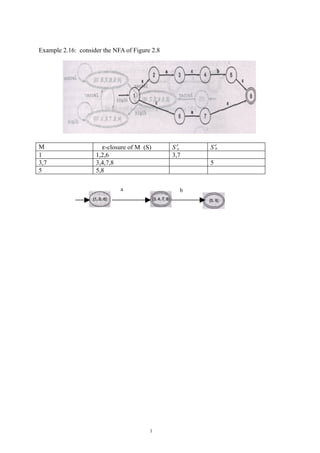
Chapter 2 2 1 2
- 1. Example 2.16: consider the NFA of Figure 2.8 M ε-closure of M (S) S′a S′b 1 1,2,6 3,7 3,7 3,4,7,8 5 5 5,8 a b 1
- 2. Example 2.17: consider the NFA of Figure 2.9 (regular expression letter(letter|digit)*) M ε-closure of M (S) S′letter S′digit 1 1 2 2 2,3,4,5,7,10 6 8 6 4,5,6,7,9,10 6 8 8 4,5,7,8,9,10 6 8 le tte r 2
- 3. 2.4.3 Simulating an NFA using the subset construction As mentioned at section 2.3. NFAs can be implemented in similar ways to DFAs, except that since NFAs are nondeterministic, there are potentially many different sequences of transitions that must be tried. A program that simulates an NFA must store up transitions that have not yet been tried and backtrack to them on failure. An other way of simulating an NFA is to use the subset construction, but instead of constructing all the states of the associated DFA, we construct only the state at each point that is indicated by the next input character. The advantage: we may not need to construct the entire DFA. In example 2.16, the input string consisting of the single character a. a b The disadvantage: a state may be constructed many times, if the path contains loops. In example 2.17, given the input string r2d3 2.4.4 Minimizing the number of states in a DFA The process we have described of deriving a DFA algorithmically from a regular expression has the unfortunate property that the resulting DFA may be more complex than necessary. For example 2.15 we derived the DFA for the regular expression a*: whereas the DFA will do as well. a 3
- 4. An important result from automata theory states that, given any DFA, there is an equivalent DFA containing a minimum number of states, and, that this minimum-state DFA is unique (except for renaming of states). It is also possible to directly obtain this minimum-state DFA from any given DFA. Given the algorithm as follow: (1) It begins with the most optimistic assumption possible. It creates two sets, one consisting of all the accepting states and the other consisting of all the non-accepting states. (2) Given this partition of the states of the original DFA, consider the transitions on each character a of the alphabet. If all accepting states have transitions on a to accepting states, then this defines an a-transition from the new accepting state (the set of all the old accepting states) to itself. If all accepting states have transitions on a to non-accepting states, then this defines an a-transition from the new accepting state to the new non- accepting state (the set of all the old non-accepting stales). On the other hand, if there are two accepting states s and t that have transitions on a that land in different sets, then no a-transition can be defined for this grouping of the states. We say that a distinguishes the states s and t We must also consider error transitions to an error state that is non- accepting. If there are accepting states s and t such that s has an a-transition to another accepting state, while t has no a-transition at all (i.e., an error transition), then a distinguishes s and t. (3) If any further sets are split, we must return and repeat the process from the beginning. This process continues until either all sets contain only one element (in which case, we have shown the original DFA to be minimal) or until no further splitting of sets occurs. 4
- 5. le tte r Example 2.18: The regular expression letter(letter|digit)* The accepting sets {2,3,4,5,7,10},{4,5,6,7,9,10},{4,5,7,8,9,10} The nonaccepting sets {1} The following minimum-state DFA : letter digit Example 2.19: the regular expression (a| ε)b* The accepting sets {1,2,3} The non-accepting sets state 1 has an a-transition to an accepting state, while states 2 .and 3 have no a-transition (or, rather, an error transition on a to the error nonaccepting state). Thus, a distinguishes state 1 from states 2 and 3, and we must repartition the states into the sets {1} and {2,3}. Now we begin over. The set {1} cannot be split further, so we no longer consider it. Now the states 2 and 3 cannot be distinguished by either a or b. 5